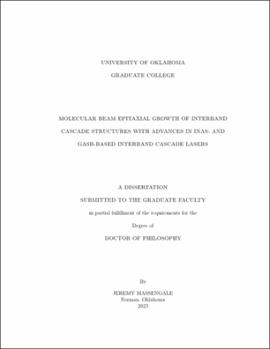| dc.description.abstract | Interband cascade lasers (ICLs) based on the type-II quantum well (QW) active region have attracted much interest over the years, in large part due to their low power consumption. Their operation hinges on two key features; interband transitions in type-II quantum wells and a cascade configuration which enhances the gain, per current density. The cascade configuration forms an energy staircase where an injected electron recombines with a hole within the active region of a single cascade stage to generate a photon, and is then quickly swept into the next cascade stage, where the same process may occur. In this way, each injected electron may generate a photon for every cascade stage it travels through, allowing for quantum efficiencies that exceed the conventional limit of unity. The overall ICL structure is built from a combination of multiple superlattice (SL) heterostructures, forming as many as hundreds of individual layers, with some of the layers having sub-nanometer thicknesses. Therefore, the growth of these devices requires atomic layer precision in thickness control in order to achieve an overall strain-balanced system where defects are minimized, leading to superior crystalline quality and acceptable device performance. Molecular beam epitaxy is a crystal growth technique that is ideal for this endeavor, with growth of IC related structures spanning a range of III-V materials including InAs, GaSb, AlSb, and their related alloys on both InAs and GaSb substrates. A variety of MBE optimization and calibration efforts are presented, which tackle some of the most important SL and alloy structures in the ICL. Methodologies are developed to achieve nearly lattice-matched alloys with ideal composition parameters and minimal surface defects, characterized by differential interference contrast microscopy (DIC) and x-ray diffraction (XRD). Also, new growth techniques are developed and employed to achieve superior crystalline quality in SL systems, which led to nearly an order of magnitude reduction in the perpendicular mismatch between measurable SL structures and the substrate, and was implemented in GaSb-based ICLs to achieve the first ever growth of these structures on the GENxplor system in our group. While GaSb-based ICLs have demonstrated efficient room temperature (RT) operation in the 3-6 µm range, extending the operating wavelength of these ICLs presents several challenges including the reduced thermal conductivity of the optical cladding layers and the diminished electron-hole wavefunction overlap in the type-II QW, which arises due to the increased InAs QW width needed to support long wavelength emission. To alleviate the former concern, an advanced waveguide that was originally developed for InAs-based ICLs operating at 4.6 µm[7] was employed in InAs-based ICLs designed to emit beyond 10 µm. The advanced waveguide may enhance the device performance by reducing the free-carrier loss and improving the optical confinement in the cascade active region. Broad area (BA) devices made from InAs-based ICL wafers with this design feature showed operation in cw mode up to 10.9 µm at 80 K with output powers of up to 32 mW/facet, the largest output power among interband lasers at this wavelength, and up to 11.5 µm at 137 K in pulsed mode, the longest emission wavelength achieved for the standard W-QW active region ICL. To address the issue of the diminished electron-hole wavefunction overlap at longer wavelengths, InAs0.5P0.5 barriers are introduced, in addition to the standard AlSb barrier, in the W-QW active region, which have a lower valence band edge than the traditional AlSb barrier used. Based on the relevant perspective on band edge positions in type-II heterostructures[8], a barrier material with As or P containing compounds lowers the electronic state in the InAs QW. This allows the InAs well width to be reduced, or at least not increased as much, in devices designed to operate at longer wavelengths, which preserves a more substantial wavefunction overlap with the GaInSb hole well. The first implementation of this design yielded ICLs operating in pulsed mode up to 120 K beyond 13.2 µm, which is the longest wavelength ever achieved among III-V interband lasers and validated the prediction that such barrier layers could enhance the long wavelength emission.[8] ICLs with revised designs utilizing the advanced waveguide and the InAs0.5P0.5 barriers exhibited cw operation beyond 12.4 µm, which is the first demonstration of a BA ICL operating in cw mode at such a long wavelength, and up to 150 K, beyond 13 µm in pulsed mode. CW output powers beyond 12 mW/facet were measured, comparable with and even higher than previous ICLs without InAs0.5P0.5 barriers operating at much shorter wavelengths (<10 µm).[9]
The advanced waveguide was also investigated in GaSb-based ICLs tailored to emit near 3.3 and 3.4 µm at RT. The implementation of this feature resulted in cw operation of BA ICLs up to 260 K and pulsed operation up to 390 K, with RT threshold current densities as low as 151 A/cm2, akin to other GaSb-based ICLs using the conventional waveguide at similar wavelengths.[10] Furthermore, the characteristic temperature (To) of some of these ICLs was nearly 60 K at RT, which is the highest among RT ICLs with similar lasing wavelengths, indicating the potential for the advanced waveguide in GaSb-based ICLs designed to emit at shorter wavelengths. | en_US |
